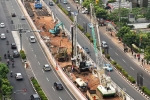This article has been translated by PwC Indonesia as part of our Indonesia Infrastructure News Service. PwC Indonesia has not checked the accuracy of, and accepts no responsibility for the content.
Investor Daily - Interkoneksi Sumatera-Jawa adopsi teknologi HVDC
19 June 2025
By Rangga Prakoso
Jakarta, ID – The Ministry of Energy and Mineral Resources (MEMR) has announced that the Sumatra–Java interconnection will utilise High Voltage Direct Current (HVDC) technology. The 112-kilometre circuit transmission line is one of the government’s priority projects currently in preparation.
This electricity infrastructure project is part of a 48,000-kilometre transmission network programme to be developed over the next ten years, as outlined in the 2025–2034 Electricity Supply Business Plan (RUPTL). The transmission network will support the utilisation of renewable energy to meet the needs of communities across various regions.
Muhadi, Coordinator of Electricity Transmission Planning at the MEMR, stated that inter-island interconnection is part of the Indonesia Supergrid programme, which aims to strengthen national energy resilience.
“To realise the Indonesia Supergrid, further collaboration is needed between local and international partners in developing policy frameworks, efficient transmission systems, green financing, and public engagement,” said Muhadi in Jakarta on Wednesday (18 June 2025).
Muhadi explained that one of the government’s priority projects is the Sumatra–Java Interconnection, spanning approximately 112 kilometres. The project aims to transmit renewable energy potential from Sumatra to major consumption centres in Java. HVDC technology has been adopted for this initiative.
“HVDC, whether via overhead lines or submarine cables, has been identified as the most feasible technical solution for this project,” he said.
In addition, the development of a 500 kV High Voltage Alternating Current (HVAC) transmission network is underway in Sumatra. Meanwhile, in Kalimantan, an estimated 13 gigawatts (GW) of hydropower potential from the Kayan and Mentarang Rivers requires large-scale transmission infrastructure to connect to Java and support smelter industry needs in Sulawesi.
Daisuke Yamakage from Kansai Transmission and Distribution Inc., Japan, presented HVDC technology, including converters, submarine cables, and overhead lines. He explained that HVDC can be technically implemented for inter-island interconnection projects in Indonesia.
“HVDC transmission systems can deliver large amounts of power over long distances with minimal losses. Compared to AC systems, HVDC can prevent the spread of grid disturbances caused by accidents. When connecting two countries or islands on a large scale, HVDC systems should be applied,” said Daisuke.
Implementing HVDC technology in Indonesia could accelerate smart grid integration and support the penetration of renewable energy, particularly Variable Renewable Energy (VRE), as part of the national energy transition agenda.
The government is preparing electricity infrastructure development to reach remote areas across Indonesia. This development will facilitate the interconnection of new and renewable energy (NRE) power plants to households.
“To connect renewable energy, we need a transmission network. Our NRE target is 23%, but we’re currently only at 15–16%. We have planned for NRE, but the network is not there. That is the major issue,” said MEMR Bahlil Lahadalia.
Bahlil stated that the electricity transmission development opens up investment opportunities worth Rp565.3 trillion. It also creates job opportunities across manufacturing, construction, operations, and maintenance for transmission lines, substations, and distribution, with a potential workforce of 881,132 people.
To boost the economy and create jobs, Bahlil hopes that all transmission and substation development will maximise the use of local content (TKDN), offering competitive pricing and reducing imports.
“I hope there will be no imports. Everything should be produced domestically. This investment is around Rp400–500 trillion just for transmission and substations. It is a great opportunity. We must safeguard our TKDN. Do not let this huge market go abroad—it must stay local,” Bahlil emphasised.
Contact us















